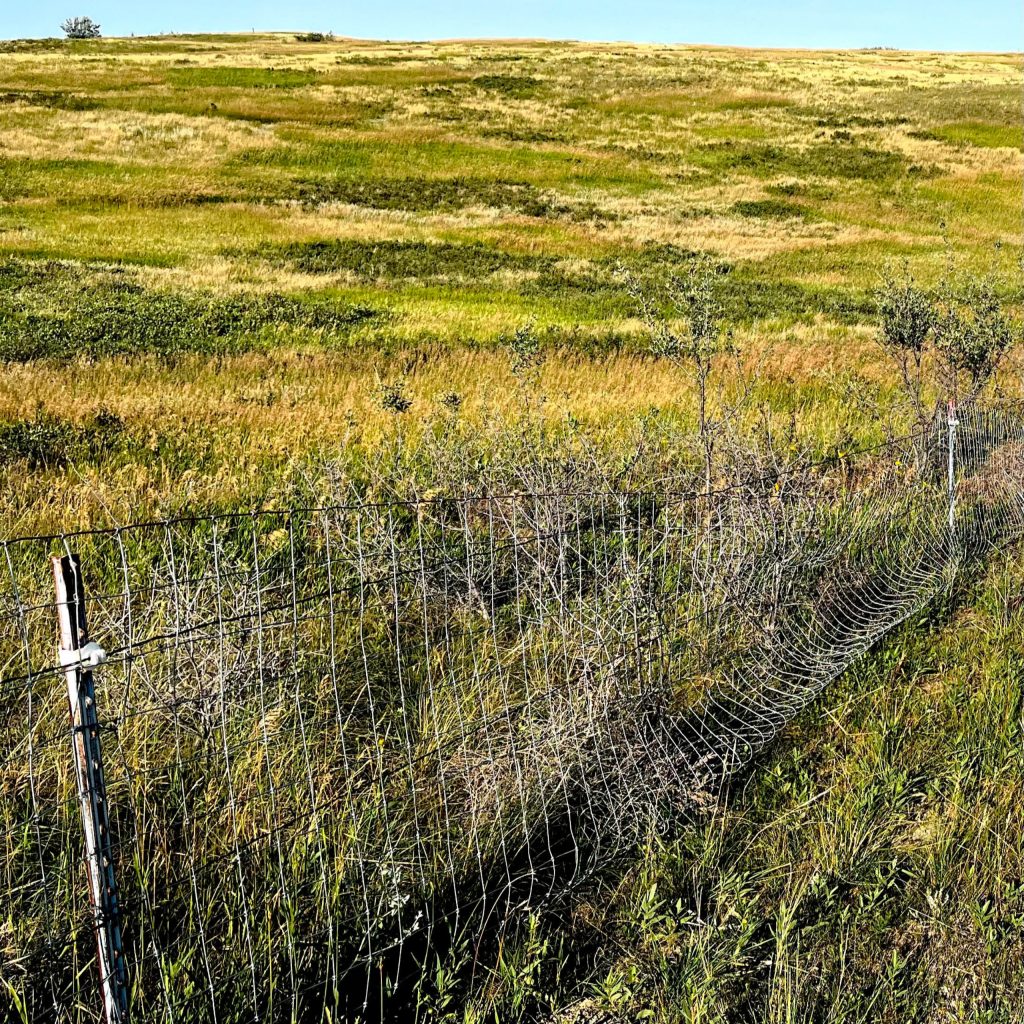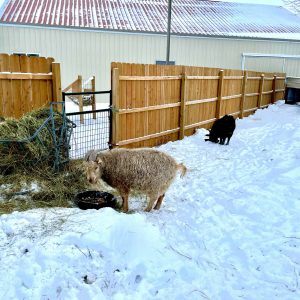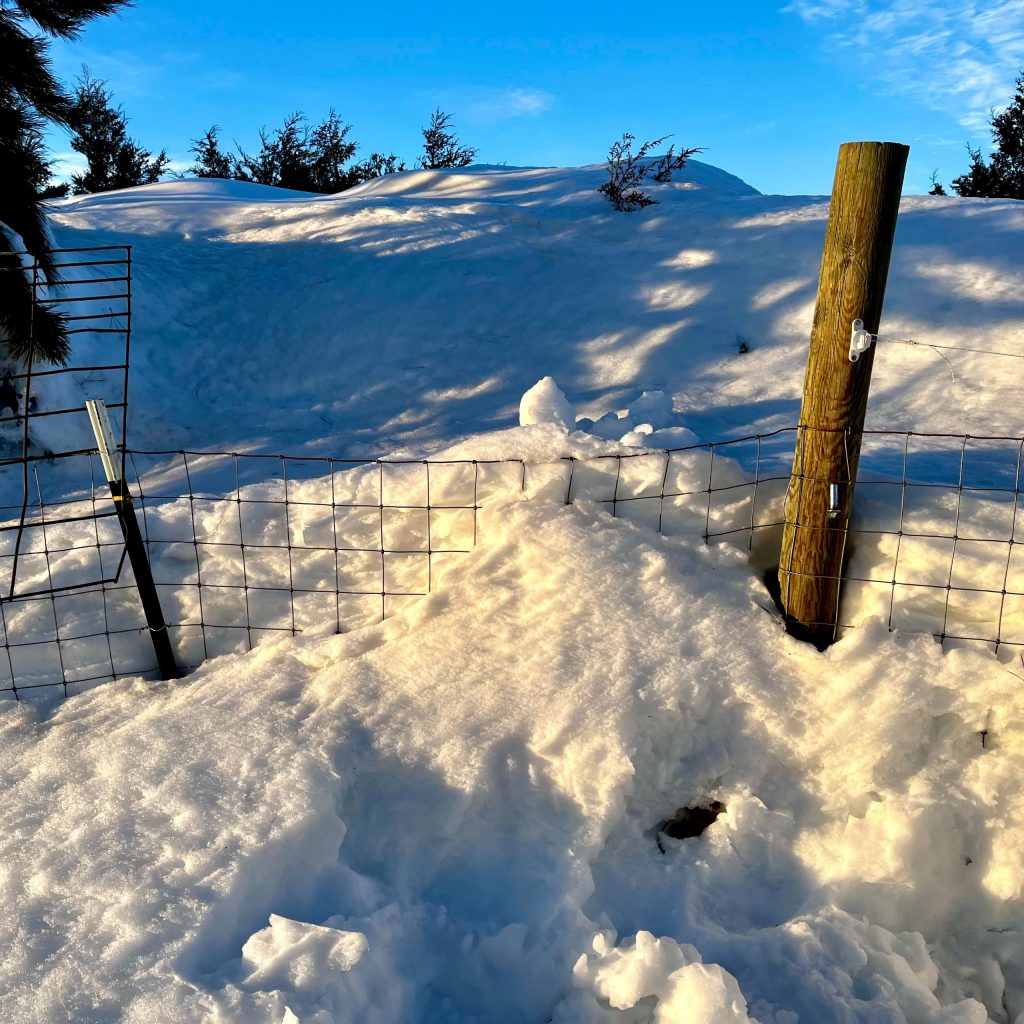January 2023
Why is it that a goat will see something on the other side of the fence, and if she thinks the grass is greener, she will proceed to find a way over, under, around, or through the fence?
Before starting your herd you want to consider what number of goats you will want to raise. Are they going to all be the same sex? Will you be pairing them up for different stages of your operation like the breeding season, weaning time, or keeping young does from bucks for a season? Will you be breeding the does at your location? Is there a tree row, a garden, a special row of machinery that will call to the goat to come to explore? Is there clearly a nicer environment directly on the other side of the fence? Where on the fence line will you be meeting the goats each day? By determining your answers to your plans for how you want to run your operation, you will have a good idea of what type of fencing you will want to have in each area you have a planned purpose for.

Taking you through what we have experienced so far will give you an idea of why you want to think about your fencing before you begin. If I hear it once, I hear it over and over, the frustration and clear amazement of folks encountering a goat owner or having once owned goats; they continue to talk about the goat jumping on a nice vehicle. They recount the story of when the goat came and jumped into the hot tub with them! Another rerun is the family that had goats and gave up simply because they could not keep them in the area they had set up for them. Hopefully telling you about our experience will help you be ahead of the goat being able to see an exploring opportunity and keep them where you want them.

Woven Wire Fencing
We purchased the woven wire goat and sheep fence from our local farm supply store. The openings were 4″ x 4″ and the height was 4′ high. This wire fencing can be attached to metal T-posts with metal clips. This is fairly easy to roll out and for the amount of area, we were covering it fit our budget. We used wooden posts on corners and frames of where the gates were going. Here is what has happened. A record-breaking snowstorm covered the north line of fencing. The tree row that lined this row of fencing helped bank the snow even higher than the 24″ of snow that fell. The large snow drifts saged the fencing. When the snow melted; it did not take Turbo our young buck long to discover that saged fence was just like a ladder. He quickly learned how to climb any area that offered a stepping ladder feel to it and out of the pasture he came. To remedy this we added an electric line across the top of the fence line. In hind site, we needed to make the T-posts closer together. We needed to test to see if a goat standing on his hind feet would cause a sage to the fence. Adding an electric wire across the top first thing would have trained the goat to know better than to even go near the fence. Because Turbo is a buck and because there are does and past wether buddies he grew up with just on the other side of the fence; this caused a reason Turbo wanted to get out of his buck pasture. Remember, if the goat is content in her/his area and does not see something she/he has to go explore then you are 90% in the clear of having to go get a goat back into its pasture again and again. The other area that started to create a weak link was the areas the goats came to each day when we went to see them. One goat standing on her/his hind feet using the top of the fence to hold them up is one thing, several goats doing this at the same time is an enormous amount of weight and the woven wire fence just did not cut it. Attaching the wire fence to wooden posts was also a surprise waiting to happen. The common staple nail was the nail Denny grew up using for attaching a wire to wood. So, if a hammer claw can get this nail to move out of its location, what do you think a buck going after his doe in heat is going to do? YOU GUESSED IT! Those nails will pop right out. I am not the strongest person on the farm so welding a large hammer and holding an exposed piece of wire under a time restraint is just not going to end up with success. Now, scissors and a piece of soft, strong pliable rope that can be cut with scissors is way quicker and helped me in many a situation where I needed to get that fencing attached to that post pronto!! Keep in mind what sort of pressure you are going to have at gathering areas, gates, and places where the goat is simply going to want to get to the other side.


Hog wire panels
Having a garden, I had found an easy way to make a fence around the plot that allowed me to take a panel down when I needed to drive a tractor into the garden. The panels were the trusty welded hog panels. The panel we had used for my garden was 4′ high, had 4″ x4″ openings and it came in a long length that 2 people could handle getting off the trailer onto the T- posts. As it was my garden it really didn’t need posts close together as long as they stood up to the ND winds. When a fence out in the goat pasture was failing it was a quick fix to bring a hog panel to the rescue. We are now considering a total remake of the areas close to the pole barn, areas that are next to gates where the herd comes to greet us, and any area that butts up to any pasture that is right next to a pasture that has another goat in it that can not under any circumstance be in with the other goat/goats in that other pasture. Our tractor has a post-hole digger attachment. We can use this to dig a deep hole to secure a wooden post. If the hog panel is 15′ – 20″ long, we will use 3 posts to secure it. One on each end and one in the middle. The end posts will be the start posts for the next hog panel. Having a supply of hog panels around to use for kidding pens, hay feeders, and quick reinforcements has helped us immensely. The other quick and useful supply I use to quickly attach this emergency reinforcement is zip ties. Realizing that a plastic zip tie will eventually crack and break, I found metal ties that semi-truck drivers use to lock the back of the trailer. Once they are locked into place that metal tie worked for me.

Wooden Fence Panels
When setting up our first 2 areas for the herd I wanted a solution for a barrier fence between the buck area and the doe area that would keep the goats from seeing each other. I thought if they couldn’t see each other then they wouldn’t try to push the fence down. YOU know, don’t you! Goats have noses too! We had the does able to come and go in and out of the pole barn our first winter. Turbo and Cash our 2 bucks were going to hunker down in a steel portable structure that we covered in straw bales. The wooden fence line divided the two areas and prevented the bucks and the does from seeing each other. We also used a row of wooden fence panels on the inside of the pole barn to create the inside area where the does would stay. Because the panels are 6′ high, it did create an instant visual barrier and the goats do not try to climb this wall. It simply doesn’t have any ladder opportunities. Several weak links in our wooden fence panels showed up after our first season. We went to clean the barn. What we thought we would be doing is taking down one of the fence lines inside the pole barn to grant us access with our tractor with a loader on it for cleaning. Let me just tell you right now. Do it once. Do it right. Save yourself time and money. We realized that we were NOT going to take down any fence inside the pole barn when it came time to clean the doe area. We then realized that where we had placed the wooden fence panels outside the pole barn made it impossible to drive into the large sliding door that normally would have been the clear solution for gaining access into the barn for cleaning. Luckily we had lots of areas where we could add more pastures and more gates and more places we could put the does and the bucks while we proceeded to get access into the barn. The wooden fence panel came down and the does enjoy seeing where the bucks had hung out while we awaited our next brilliant barrier plan. If you are using wooden fence panels inside where the does will be possibly kidding or having tiny goat kids around them, look for gaps. When our doe Grace delivered her twins she did so all on her own. We have barn cameras, Looking at the doe pen on Christmas Eve morning I noticed a small white dot near the gate. Looking closer I realized it was a baby goat! Rushing to the pole barn to check on Grace and find out how this newborn was doing, I was so excited to see a freshly dried-off baby kid goat all healthy and looking well-fed. Then why was I hearing distressed crying?? Sure enough, Grace’s twin has scooted himself into the small gap behind the wooden panel. He was clearly stuck and would not have ever found his way out to his mom! We have since covered all gaps with – YOU GUESSED IT – hog panels.


Woven Electric Portable fencing
Before we understood what we could do with the land available for our goats, Denny went ahead and ordered electric woven portable fencing. The fencing was 3′ high and 100′ long. He ordered 2 sets. This instant fencing comes in several heights and for goats, you must have 4′ high. The entire woven fencing will give the animal touching the webbing an electric shock. It can connect to another stand of woven fencing so you can make it longer if needed. You do not need electricity to power this fencing as you are able to purchase a solar energizer for the fencing. Before I tear my entire filing cabinet apart trying to find the exact product we ordered, I will stop right now and tell you it was the incorrect height! During our first summer with our herd, we knew we wanted to keep the twin doelings away from the buck. Denny had organized a crew of helpers to create a larger pasture. During the day we simply let the dolings and weather go play out near this pasture as they stuck around the herd and yet were not in with the herd. We set the portable web fencing up so the doelings could graze on the abundant green grass growing over our septic system’s drain field. The crew was working away installing T-posts with a fencing pounder we had rented for the day. If I only would have had my camera ready. The doelings startled by the pounding sound of the fence installer took a running leap and over the 3′ fence, they went! Once a goat understands she can get over a fence, there is no keeping her in. We now use the 200′ of web fencing to reinforce a fence line or to put it up to direct traffic away from an area we are working on and don’t want the goats to hang out by. If ordering this fencing; you will want a 4′ height at a minimum. The company that we purchased our portable webbing fencing from is Premier 1 Supplies.

Custom-made portable panels allow us access to the pole barn.

Portable metal panels
Living in North Dakota with a population under 800,000; it is hard to not consider anywhere you live rurally. Either you went to school with a rancher/farmer or you work with folks that live on a ranch/farm operation. Both my husband’s heritage and mine come from farming occupations. You would think by simply growing up around this community I would know more about the options of securing livestock in an area you want to keep them in. I have so much to learn and know! When explaining what we were up to one day to my sister who lives in a functioning livestock operation; I asked if I could speak to her husband. It was about 2 seconds when he said, ” YOU NEED PORTABLE PANELS”! I drove by these metal objects often and yet I had not understood what they really were. A cattle panel is heavy metal welded to make a long fence panel that connects with another panel. A cattle producer will use these panels in many situations. Remember I was talking about pressure areas? Well, how about a herd of 1000 lb bulls being rounded up into a small area to have cowhands “work ” on them for the afternoon? Talk about pressure! After checking in with the manufacturers of livestock panels in our area I found the company that would make us panels specified to my criteria. These panels could be moved with a tractor (or 2 people for each panel) to make up any combination of barriers we needed. Our immediate need was to put a barrier back between the doe area and the buck area. We had torn down the wooden panels to clean the inside of the pole barn and we had moved the bucks to their summer pasture. Winter was coming and we needed to get that barrier up before we could move the bucks into their winter quarters. Stur-D-Products Co. produced 4 panels and met our timeline. These panels were designed to have tightly woven fencing for 30″ from the ground up. The total height of the panel is 5′. The width between the panel rungs after the 30″ of meshing is 6″, 8″, 8″, 8′ for a total height of 60″. Each panel can stand on its own as they were made with feet that help them stand independently. We plan on ordering more of these custom-made panels to help accommodate inside cleaning of the buck area.
What fence do you need for your goat goals?
The key to your answer is in “your goals”. As a Pygora goat is such a sweet, friendly, fiber maker; you may want to simply own a pair of does with wether to keep it a trio for growing and harvesting your own fiber. Not having breeding in mind eliminates the buck pressure. This also eliminates having to have another area for kidding and another area ready for when you wean the kids. Not having breeding as part of your goals makes your decision on fencing a whole lot simpler. A doe that simply is happy where she is will not be messing with the fence. A doe that is not able to graze yet looks at luscious grass on the other side of the fence will cause fence pressure. As you start to understand what your homestead is going to hold as well as produce; you will know what areas you need to fence to meet the needs of your fiber growing.

Challenges
Challenges still arrive each season. Heavy snowfalls covered our fence lines. The fences that ran along anything that stopped the snow from blowing away would bank up. Our fence line that runs along the north side of our buck area is directly in line with a shelter belt. The tree rows/shelter belt created 12′ high snow banks covering the 4′ high fence with the weight and pressure of a mini glacier. When Spring arrives the woven wire fence line will no longer be a smooth fence line. The fence will have sagged and the sagged fence will resemble a stepping ladder. Keep in mind, while the snow drift is hardening and staying over the fence line, it has now become a bridge the goat herd can now walk out and over.

We are considering our options and monitoring the areas snow drifts can be created. Will it be worth our effort to move the fence to the north of the tree row versus the south? The difference in snowdrift height is significant. Is there another solution? We want to not bankrupt the fencing budget. What is our time and peace of mind worth?
This was an absolute delight to read. Your composition has me sensing motivated!
my blog post: e transfer payday loans canada 24 7 no credit check
This article was directly up my arena! Cheers for accommodating people with my
pursuits.
Here is my web site bc online payday loans
It’s amazing to visit this website and reading thee viewss of all friends regarding
this article, whle I am also keen of getting knowledge. https://odessaforum.biz.ua/